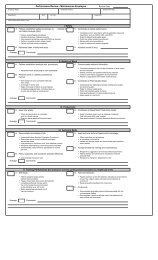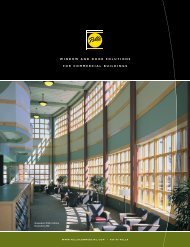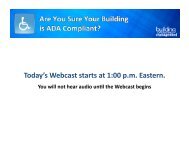Building Operating Management September 2011 - FacilitiesNet
Building Operating Management September 2011 - FacilitiesNet
Building Operating Management September 2011 - FacilitiesNet
You also want an ePaper? Increase the reach of your titles
YUMPU automatically turns print PDFs into web optimized ePapers that Google loves.
70<br />
buildingoperatingmanagement<br />
SEPTEMBER <strong>2011</strong><br />
ics, reductions in the workforce and<br />
environmental considerations. All of<br />
these issues continue to be vital concerns<br />
in the market. In fact, a recent<br />
poll about roof purchasing habits<br />
indicates that environmental issues<br />
are now the No. 1 factor in the selection<br />
of roof materials for consumers,<br />
while the material’s ease of application<br />
is the first priority in the contractor’s<br />
selection process.<br />
New Codes and Regulations<br />
Before taking a look at the specific<br />
requirements of the various codes and<br />
voluntary rating systems, it’s important<br />
to understand the metrics they use.<br />
Reflectivity ratings are based on<br />
core drilling<br />
& trenching?<br />
cut it out!<br />
<br />
<br />
<br />
<br />
<br />
<br />
Connectivity with flexibility<br />
<br />
the roof surface’s ability to reflect ultraviolet<br />
rays from the sun. Studies<br />
have indicated that reflective surfaces<br />
will cool the building in the summer,<br />
decreasing the use of air conditioning,<br />
which decreases cooling costs and energy<br />
capacity. The Energy Star program<br />
establishes the reflectivity rate of a roof<br />
surface for low-slope (less than 2:12)<br />
roof systems at .65 the first three years<br />
and .50 after three years. LEED provides<br />
points based on this program.<br />
Emissivity measures the ability of<br />
a roof to emit back to the atmosphere<br />
the solar energy that it has absorbed,<br />
rather than transferring that absorbed<br />
energy to the interior of the building.<br />
Finally, the Solar Reflective Index (SRI)<br />
is a relatively new measure that combines<br />
solar reflectivity and emissivity. It<br />
is calculated via ASTM standard E 1980.<br />
LEED for New<br />
Construction’s<br />
“heat island reduction”<br />
credit gives one point<br />
for a reflective roof with<br />
an SRI of at least 78<br />
The past decade has seen a concentrated<br />
effort to develop standards<br />
for environmental and sustainable<br />
materials. So far, these standards have<br />
not been added to the International<br />
<strong>Building</strong> Code (IBC). However, some of<br />
these regulations have become codes<br />
in select municipalities and states. For<br />
instance, in California, Title 24, the<br />
state’s energy code, has been part of<br />
the state building code for a number of<br />
years. Several municipalities throughout<br />
the country have incorporated<br />
Energy Star roof reflectivity ratings into<br />
their codes. And most industry experts<br />
agree that it is just a matter of time before<br />
LEED becomes part of the IBC.<br />
In fact, the new International Green<br />
Construction Code, due out in 2012,<br />
will include standards for cool roofing.<br />
LEED is a green building rating system<br />
based on points through energy<br />
▲ FREE INFO: Circle 451





